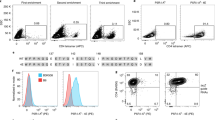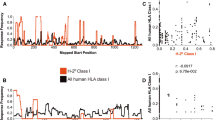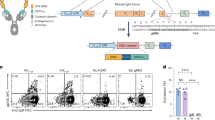Abstract
The CD4 (T4) antigen was originally described as a phenotypic marker specific for helper T cells, and has recently been shown to be the receptor for the human immunodeficiency virus (HIV)1–4. Functional studies using monoclonal antibodies directed at CD4 and major histocompatibility complex (MHC) class II molecules led to the suggestion that CD4 binds to the MHC class II molecules expressed on stimulator cells, enhancing T-cell responsiveness by increasing the avidity of T cell-stimulator cell interaction and/or by transmitting a positive intracellular signal5–11. But recent evidence that antibodies to CD4 inhibit T-cell responsiveness in the absence of any putative ligand for CD4 has been interpreted as suggesting that antibody-mediated inhibition may involve the transmission of a negative signal via the CD4 molecule instead12–14. We have infected a murine T-cell hybridoma that produces inter-leu kin 2 (IL-2) in response to human class II HLA-DR antigens with a retroviral vector containing CD4 cDNA. The resulting CD4-expressing hybridoma cell lines produce 6- to 20-fold more IL-2 in response to HLA-DR antigens than control cell lines. Furthermore, when antigen levels are suboptimal, the response of the cell lines is entirely CD4-dependent. The data presented here clearly demonstrate that CD4 can enhance T-cell responsiveness and may be crucial in the response to suboptimal levels of antigen.
This is a preview of subscription content, access via your institution
Access options
Subscribe to this journal
Receive 51 print issues and online access
$199.00 per year
only $3.90 per issue
Buy this article
- Purchase on SpringerLink
- Instant access to full article PDF
Prices may be subject to local taxes which are calculated during checkout
Similar content being viewed by others
References
1. Reinherz, E. L., Kung, P., Goldstein, G. & Schlossman, S. Proc. natn. Acad. Sci. U.S.A. 76, 4061–4065 (1979). 2. Dalgleish, A. G. et al. Nature 312, 763–767 (1984). 3. Klatzmann, D. et al. Nature 312, 767–768 (1984). 4. McDougal, J. S. et al. Science 231, 382–385 (1986). 5. Krensky, A. M., Reiss, C. S., Mier, J. W., Strominger, J. L. & Burakoff, S. J Proc. natn. Acad. Sci. U.S.A. 79, 2365–2369 (1982). 6. Meuer, S. C., Schlossman, S. F. & Reinherz, E. L. Proc. natn. Acad. Sci. U.S.A. 79,4395–4399 (1982). 7. Biddison, W. E., Rao, P. E., Talle, M. A., Goldstein, G. & Shaw, S. /. exp. Med. 156, 1065–1076 (1982). 8. Marrack, P. et al. J. exp. Med. 158, 1077–1091 (1983). 9. Greenstein, J. L., Malissen, B. & Burakoff, S. J. /. exp. Med. 162, 369–374 (1985). 10. Greenstein, J. L., Kappler, J., Marrack, P. & Burakoff, S. J. /. exp. Med. 159,1213–1224 (1984). 11. Shaw, S., Goldstein, G., Springer, T. A. & Biddison, W. A. /. Immun. 134,3019–3026 (1985). 12. Bank, I. & Chess, L. J. exp. Med. 162, 1294–1303 (1985). 13. Greenstein, J. L. & Burakoff, S. J. Ann. Inst. Pasteur/Immun. 138, 134–138 (1987). 14. Tite, J. P., Sloan, A. & Janeway, C. A. /. molec. cell. Immun. 2, 179–190 (1986). 15. Sanchez–Madrid, F. et al. Proc. natn. Acad. Sci. U.S.A. 79, 7489–7493 (1982). 16. Gorga, J. C., Knudsen, P. J., Foran, J. A., Strominger, J. L. & Burakoff, S. J. Cell. Immun. 103, 160–173 (1986). 17. Staerz, U., Rammensee, H. G., Benedetto, J. D. & Bevan, M. J. /. Immun. 134, 3994–4000 (1985). 18. Dialynas, D. P. et al Immun. Rev. 74, 29–56 (1983). 19. Sattentau, Q. J., Dalgleish, A. G., Weiss, R. A. & Beverley, P. C. L. Science 234, 1120–1123 (1986). 20. Mescher, M, F., Stallcup K. C., Sullivan, C. P., Turkewitz, A. P. & Hermann, S. H. Meth. Enzym. 92, 86–109 (1983). 21. Rothstein, A. M. et al. J. Immun. 122, 2491–2497 (1979). 22. Ely, J. M. et al. J. Immun. 127, 2345–2349 (1981). 23. Gillis, S., Perm, M. M., Ou, W. & Smith, K. A. /. Immun. 120, 2027–2032 (1978). 24. Sussman, D. J. & Milman, G. Molec. cell Biol. 4, 1641–1643 (1984).
Author information
Authors and Affiliations
Rights and permissions
About this article
Cite this article
Sleckman, B., Peterson, A., Jones, W. et al. Expression and function of CD4 in a murine T-cell hybridoma. Nature 328, 351–353 (1987). https://doi.org/10.1038/328351a0
Received:
Accepted:
Issue date:
DOI: https://doi.org/10.1038/328351a0
This article is cited by
-
Soluble Forms of the Human T Cell Receptor CD4 are Efficiently Expressed by Streptomyces lividans
Nature Biotechnology (1993)
-
Association of tyrosine kinase p56lck with CD4 inhibits the induction of growth through the αβ T-cell receptor
Nature (1992)
-
MHC class II interaction with CD4 mediated by a region analogous to the MHC class I binding site for CD8
Nature (1992)
-
Enhancement of T-cell activation by the CD43 molecule whose expression is defective in Wiskott–Aldrich syndrome
Nature (1991)



